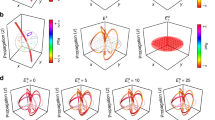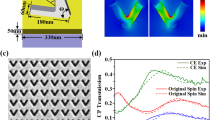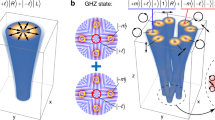Abstract
The fundamental polarization singularities of monochromatic light are normally associated with invariance under coordinated rotations: symmetry operations that rotate the spatial dependence of an electromagnetic field by an angle θ and its polarization by a multiple γθ of that angle. These symmetries are generated by mixed angular momenta of the form Jγ = L + γS, and they generally induce Möbius-strip topologies, with the coordination parameter γ restricted to integer and half-integer values. In this work we construct beams of light that are invariant under coordinated rotations for arbitrary rational γ, by exploiting the higher internal symmetry of ‘bicircular’ superpositions of counter-rotating circularly polarized beams at different frequencies. We show that these beams have the topology of a torus knot, which reflects the subgroup generated by the torus-knot angular momentum Jγ, and we characterize the resulting optical polarization singularity using third- and higher-order field moment tensors, which we experimentally observe using nonlinear polarization tomography.
This is a preview of subscription content, access via your institution
Access options
Access Nature and 54 other Nature Portfolio journals
Get Nature+, our best-value online-access subscription
$29.99 / 30 days
cancel any time
Subscribe to this journal
Receive 12 print issues and online access
$209.00 per year
only $17.42 per issue
Buy this article
- Purchase on Springer Link
- Instant access to full article PDF
Prices may be subject to local taxes which are calculated during checkout



Similar content being viewed by others
Data availability
The data used to generate the experimental figures in this paper have been publicly archived in the Zenodo repository at https://doi.org/10.5281/zenodo.2649391.
Code availability
The code used to generate the theoretical figures, and the scripts used to process the experimental data, have been publicly archived in the Zenodo repository at https://doi.org/10.5281/zenodo.2649391.
Change history
21 August 2019
When this Article was originally published, the file for Supplementary Data 1 was missing; it has now been added.
References
Torres, J. P. & Torner, L. (eds) Twisted Photons: Applications of Light with Orbital Angular Momentum (Wiley, 2011).
Andrews, D. L. & Babiker, M. (eds) The Angular Momentum of Light (Cambridge University Press, 2012).
Gbur, G. Singular Optics (CRC Press, 2016).
Rubinsztein-Dunlop, H. et al. Roadmap on structured light. J. Opt. 19, 013001 (2017).
Nye, J. F. & Berry, M. V. Dislocations in wave trains. Proc. R. Soc. A 336, 165–190 (1974).
Wang, J. et al. Terabit free-space data transmission employing orbital angular momentum multiplexing. Nat. Photon. 6, 488–491 (2012).
Fürhapter, S., Jesacher, A., Bernet, S. & Ritsch-Marte, M. Spiral phase contrast imaging in microscopy. Opt. Express 13, 689–694 (2005).
Garcés-Chávez, V., Volke-Sepulveda, K., Chávez-Cerda, S., Sibbett, W. & Dholakia, K. Transfer of orbital angular momentum to an optically trapped low-index particle. Phys. Rev. A 66, 063402 (2002).
Padgett, M. & Bowman, R. Tweezers with a twist. Nat. Photon 5, 343–348 (2011).
Hernández-García, C. et al. Generation and applications of extreme-ultraviolet vortices. Photonics 4, 28 (2017).
Barnett, S. M. et al. On the natures of the spin and orbital parts of optical angular momentum. J. Opt. 18, 064004 (2016).
Molina-Terriza, G., Torres, J. P. & Torner, L. Twisted photons. Nat. Phys. 3, 305–310 (2007).
Van Enk, S. & Nienhuis, G. Spin and orbital angular momentum of photons. Eur. Phys. Lett. 25, 497–501 (1994).
Kedia, H., Bialynicki-Birula, I., Peralta-Salas, D. & Irvine, W. T. M. Tying knots in light fields. Phys. Rev. Lett. 111, 150404 (2013).
Leach, J., Dennis, M. R., Courtial, J. & Padgett, M. J. Laser beams: knotted threads of darkness. Nature 432, 165 (2004).
Dennis, M. R., King, R. P., Jack, B., O’Holleran, K. & Padgett, M. J. Isolated optical vortex knots. Nat. Phys. 6, 118–121 (2010).
Sugic, D. & Dennis, M. R. Knotted hopfion in tightly focused light. In Proceedings of the 4th International Conference on Optical Angular Momentum (ed. Marrucci, L.) 137 (Jean Gilder, 2017); http://www.jeangilder.it/icoam2017/abstract-book/
Larocque, H. et al. Reconstructing the topology of optical polarization knots. Nat. Phys. 14, 1079–1082 (2018).
Freund, I. Cones, spirals and Möbius strips, in elliptically polarized light. Opt. Commun. 249, 7–22 (2005).
Nye, J. F. & Hajnal, J. V. The wave structure of monochromatic electromagnetic radiation. Proc. R. Soc. Lond. A 409, 21–36 (1987).
Dennis, M. R. Polarization singularities in paraxial vector fields: morphology and statistics. Opt. Commun. 213, 201–221 (2002).
Bauer, T. et al. Multi-twist polarization ribbon topologies in highly-confined optical fields. Preprint at http://arxiv.org/abs/1901.11337 (2019).
Freund, I. Optical Möbius strips in three-dimensional ellipse fields: I. Lines of circular polarization. Opt. Commun. 283, 1–15 (2010).
Freund, I. Optical Möbius strips in three-dimensional ellipse fields: II. Lines of circular polarization. Opt. Commun. 283, 16–28 (2010).
Bauer, T. et al. Observation of optical polarization Möbius strips. Science 347, 964–966 (2015).
Bauer, T., Neugebauer, M., Leuchs, G. & Banzer, P. Optical polarization Möbius strips and points of purely transverse spin density. Phys. Rev. Lett. 117, 013601 (2016).
Galvez, E. J. et al. Multitwist Möbius strips and twisted ribbons in the polarization of paraxial light beams. Sci. Rep. 7, 13653 (2017).
Garcia-Etxarri, A. Optical polarization Möbius strips on all-dielectric optical scatterers. ACS Photonics 4, 1159–1164 (2017).
Cardano, F. & Marrucci, L. Spin–orbit photonics. Nat. Photon 9, 776–778 (2015).
Bliokh, K. Y., Rodríguez-Fortuño, F. J., Nori, F. & Zayats, A. V. Spin–orbit interactions of light. Nat. Photon. 9, 796–808 (2015).
Bliokh, K. Y. Geometrodynamics of polarized light: Berry phase and spin Hall effect in a gradient-index medium. J. Opt. A Pure Appl. Opt. 11, 094009 (2009).
Ballantine, K. E., Donegan, J. F. & Eastham, P. R. There are many ways to spin a photon: half-quantization of a total optical angular momentum. Sci. Adv. 2, e1501748 (2016).
Leach, J. et al. Interferometric methods to measure orbital and spin, or the total angular momentum of a single photon. Phys. Rev. Lett. 92, 013601 (2004).
Galvez, E. J., Coyle, L. E., Johnson, E. & Reschovsky, B. J. Interferometric measurement of the helical mode of a single photon. New J. Phys. 13, 053017 (2011).
Kessler, D. A. & Freund, I. Lissajous singularities. Opt. Lett. 28, 111–113 (2003).
Freund, I. Bichromatic optical Lissajous fields. Opt. Commun. 226, 351–376 (2003).
Fleischer, A., Kfir, O., Diskin, T., Sidorenko, P. & Cohen, O. Spin angular momentum and tunable polarization in high-harmonic generation. Nat. Photon. 8, 543–549 (2014).
Freund, I. Polychromatic polarization singularities. Opt. Lett. 28, 2150–2152 (2003).
Freund, I. Polarization critical points in polychromatic optical fields. Opt. Commun. 227, 61–71 (2003).
Yan, H. & Lü, B. Dynamical evolution of Lissajous singularities in free-space propagation. Phys. Lett. A 374, 3695–3700 (2010).
Haitao, C., Gao, Z. & Wang, W. Propagation of the Lissajous singularity dipole emergent from non-paraxial polychromatic beams. Opt. Commun. 393, 17–24 (2017).
Adams, C. C. The Knot Book: An Elementary Introduction to the Mathematical Theory of Knots (American Mathematical Society, 2004).
Rolfsen, D. Knots and Links 17–18 (American Mathematical Society, 2003).
Götte, J. B. et al. Light beams with fractional orbital angular momentum and their vortex structure. Opt. Express 16, 993–1006 (2008).
Freund, I. Coherency matrix description of optical polarization singularities. J. Opt. A Pure Appl. Opt. 6, S229 (2004).
Samim, M., Krouglov, S. & Barzda, V. Nonlinear Stokes–Mueller polarimetry. Phys. Rev. A 93, 013847 (2016).
Maucher, F., Skupin, S., Gardiner, S. A. & Hughes, I. G. Creating complex optical longitudinal polarization structures. Phys. Rev. Lett. 120, 163903 (2018).
Wilczek, F. Quantum mechanics of fractional-spin particles. Phys. Rev. Lett. 49, 957–959 (1982).
Arovas, D., Schrieffer, J. R. & Wilczek, F. Fractional statistics and the quantum Hall effect. Phys. Rev. Lett. 53, 722–723 (1984).
Lin, Y.-J., Jiménez-García, K. & Spielman, I. B. Spin–orbit-coupled Bose–Einstein condensates. Nature 471, 83–86 (2011).
Maucher, F., Gardiner, S. A. & Hughes, I. G. Excitation of knotted vortex lines in matter waves. New J. Phys. 18, 063016 (2016).
Bloembergen, N. Conservation laws in nonlinear optics. J. Opt. Soc. Am. 70, 1429–1436 (1980).
Hickstein, D. D. et al. Non-collinear generation of angularly isolated circularly polarized high harmonics. Nat. Photon. 9, 743–750 (2015).
Pisanty, E. et al. Conservation of torus-knot angular momentum in high-order harmonic generation. Phys. Rev. Lett. 122, 203201 (2019).
Pisanty, E. LISSAFIRE: Lissajous-figure reconstruction for nonlinear polarization tomography of bichromatic fields https://github.com/episanty/LISSAFIRE (GitHub); v1.0.2 https://doi.org/10.5281/zenodo.2649390 (Zenodo, 2019).
Pisanty, E. et al. Code and data for ‘Knotting fractional-order knots with the polarization state of light’ https://doi.org/10.5281/zenodo.2649391 (Zenodo, 2019).
Acknowledgements
The authors thank M. Maffei and I. Freund for helpful conversations, and X. Menino for 3D-printing assistance. E.P. acknowledges Cellex-ICFO-MPQ fellowship funding. E.P., M.L. and A.C. acknowledge funding from the Spanish Ministry MINECO (National Plan 15 Grant: FISICATEAMO no. FIS2016-79508-P, SEVERO OCHOA no. SEV-2015-0522, FPI), the European Social Fund, Fundació Cellex, Generalitat de Catalunya (AGAUR grant no. 2017 SGR 1341 and CERCA/Program), ERC AdG OSYRIS, EU FETPRO QUIC and the National Science Centre, Poland-Symfonia grant no. 2016/20/W/ST4/00314. V.V.-H. acknowledges financial support from Secretaría de Ciencia, Tecnología e Innovación de la Ciudad de México. J.P.T. acknowledges support from Generalitat de Catalunya (Program ICREA Academia). G.J.M. was supported by the Secretaria d’Universitats i Recerca del Departament d’Economia i Coneixement de la Generalitat de Catalunya, as well as the European Social Fund—FEDER. A.P. acknowledges funding from Comunidad de Madrid through TALENTO grant ref. 2017-T1/IND-5432. A.C. acknowledges financial support from the ERC Synergy Grant UQUAM, the SFB FoQuS (FWF project no. F4016-N23), the UAB Talent Research programme and from the Spanish Ministry of Economy and Competitiveness under contract no. FIS2017-86530-P.
Author information
Authors and Affiliations
Contributions
E.P. conceived the project and developed the theory. G.J.M., V.V.-H., E.P. and J.P.T. designed the experiment. G.J.M. and V.V.-H. conducted the experiment. A.P., A.C. and M.L. assisted with the theory. E.P. wrote the manuscript, with assistance from V.V.-H. for the Methods section. J.P.T. supervised the experimental work and M.L. oversaw the theory development. All authors contributed to the scientific discussion.
Corresponding author
Ethics declarations
Competing interests
The authors declare no competing interests.
Additional information
Publisher’s note: Springer Nature remains neutral with regard to jurisdictional claims in published maps and institutional affiliations.
Supplementary information
Supplementary Information
This file contains more information about the work and Supplementary Figs. 1–11.
Supplementary Data 1
3D-printable models of Fig. 1d and e.
Rights and permissions
About this article
Cite this article
Pisanty, E., Machado, G.J., Vicuña-Hernández, V. et al. Knotting fractional-order knots with the polarization state of light. Nat. Photonics 13, 569–574 (2019). https://doi.org/10.1038/s41566-019-0450-2
Received:
Accepted:
Published:
Issue Date:
DOI: https://doi.org/10.1038/s41566-019-0450-2
This article is cited by
-
Topological atom optics and beyond with knotted quantum wavefunctions
Communications Physics (2024)
-
Delay-dependent and order-dependent asymptotic stability conditions for Riemann–Liouville fractional-order systems with time delays
Computational and Applied Mathematics (2023)
-
High capacity topological coding based on nested vortex knots and links
Nature Communications (2022)
-
Color-selective three-dimensional polarization structures
Light: Science & Applications (2022)
-
Topological complex-energy braiding of non-Hermitian bands
Nature (2021)



